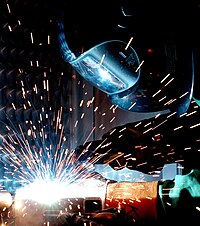
Photo from wikipedia
Abstract Aluminum alloy profiles manufactured by semi-continuous porthole die extrusion have three kinds of intrinsic features: longitudinal welds, transverse welds and back-end defects, which affect the corrosion resistance and mechanical… Click to show full abstract
Abstract Aluminum alloy profiles manufactured by semi-continuous porthole die extrusion have three kinds of intrinsic features: longitudinal welds, transverse welds and back-end defects, which affect the corrosion resistance and mechanical properties of the profiles. In this work, the microstructure, corrosion resistance and mechanical properties of these intrinsic features were studied by microstructural characterization, chemical immersion and in-situ test, and the relationship between the material flow behavior and the evolution of the back-end defect and transverse weld was revealed through numerical simulation. It is found that, in terms of corrosion resistance and mechanical properties, both the transverse weld and back-end defect are poor, while the longitudinal weld is relatively good. Impurities and oxide particles are densely distributed in the aluminum alloy matrix in the back-end defect area. In the transverse weld area, the bonding interface has impurities and oxides, and grains are separated by the bonding interface; while in the longitudinal weld area, the grains across the bonding interfaces are formed. The bonding interface of the ring-shaped transverse weld which is far from the longitudinal weld has a low bonding degree. When the transverse weld becomes no longer ring-shaped and very close to the longitudinal weld, its bonding degree is greatly enhanced. The bonding degree of all the transverse welds is lower than that of all the longitudinal welds. During the tensile tests of the extruded profiles, strain concentration phenomena occur at the positions of the longitudinal welds, transverse welds and back-end defects, and there are two types of fracture modes: “uniform plastic deformation → strain concentration → fracture” and “uniform plastic deformation → strain concentration → debonding → fracture”.
Journal Title: Journal of Materials Processing Technology
Year Published: 2019
Link to full text (if available)
Share on Social Media: Sign Up to like & get
recommendations!